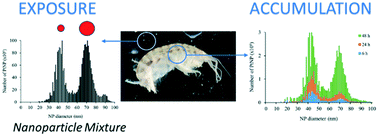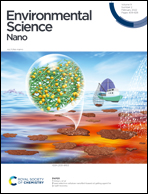Particle size determines the accumulation of platinum nanoparticles in the estuarine amphipod, Leptocheirus plumulosus†
Abstract
Nanoparticles (NPs) typically display a wide distribution of different sizes in aquatic environments, yet little information is available on the impact of particle size dispersity on organismal uptake and elimination. This study investigated uptake and elimination of polyvinylpyrrolidone-coated platinum nanoparticles (PVP-PtNPs) of different sizes (e.g., 20.0 ± 4.8 nm, 40.5 ± 4.1 nm, and 70.8 ± 4.2 nm) by the estuarine amphipod Leptocheirus plumulosus. Accumulation and elimination were determined by measuring total Pt body burden in amphipods exposed to PtNPs using inductively coupled plasma-mass spectroscopy, as well as the mass and number PtNP body burden using single particle-ICP-MS (sp-ICP-MS). L. plumulosus accumulated Pt from PtNP suspensions of different sizes from water exposure, mostly (e.g., >90%) as PtNPs rather than as dissolved Pt. Mass- and number-based uptake increased with decreases in PtNP size whereas mass- and number-based elimination increased with increasing PtNP size. The residual whole-animal body burden of PtNPs after 48 h elimination increased with decreases in PtNP size, with residual body burdens approximately two-fold higher for amphipods exposed to 20 nm PtNPs than amphipods exposed to 70 nm PtNPs. PtNP influx rate (kuw) increased with decreasing NP size, with kuws of 1.07 ± 0.31, 0.82 ± 0.22, and 0.67 ± 0.10 μg g−1 d−1 for 20 nm, 40 nm, and 70 nm PtNPs, respectively. PtNP efflux rate (ke) increased with increasing PtNP size, with kes of 0.31 ± 0.08, 0.66 ± 0.04, and 0.83 ± 0.07 d−1 for 20 nm, 40 nm, and 70 nm PtNP, respectively. When exposed to mixtures of 40 and 70 nm PtNPs with equal masses, surface areas, or number concentrations of 40 nm and 70 nm PtNPs, L. plumulosus accumulated higher numbers of the 40 nm PtNPs than 70 nm PtNPs from all mixtures. The increased exposure concentration of 70 nm PtNPs in the mixture did not affect the uptake of 40 nm PtNPs, suggesting that in a polydispersed NP suspension the uptake of a given size fraction is independent of other size fractions in the mixture.

- This article is part of the themed collection: Environmental Science: Nano Recent HOT Articles


 Please wait while we load your content...
Please wait while we load your content...
